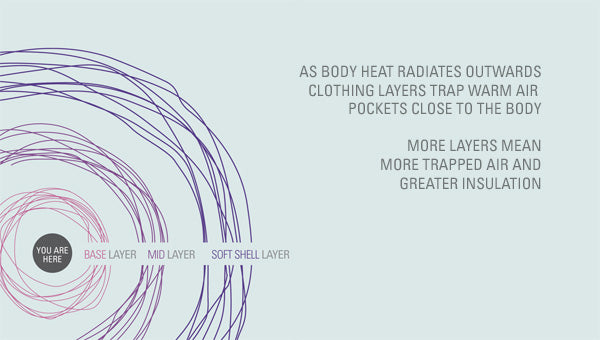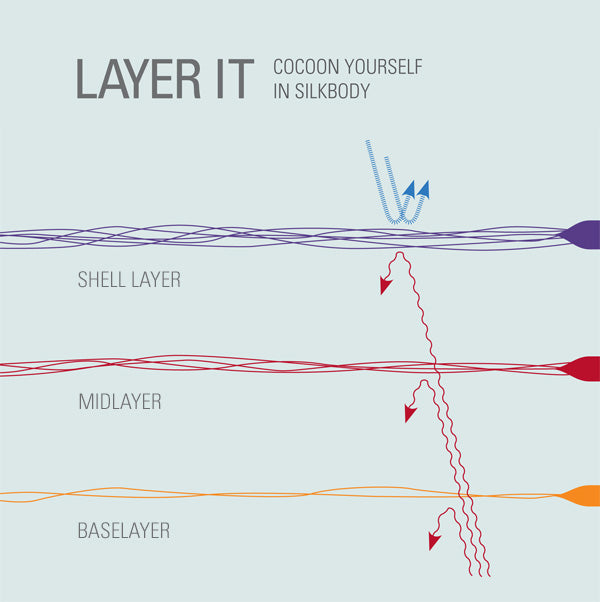
What really keeps you warm is... air! Trapping warm, still air around your body should be the aim of your insulating clothing system. Here’s our guide to achieving warmth nirvana without looking like a woolly mammoth.
Firstly, wear a protein fibre next to your skin (think silk, merino (wool) or cashmere). Protein fibres are synergistic with our skin and create an insulating second-skin that warms to our body temperature. Silk is better than wool because it dries faster, allowing the skin moisture that causes heat loss to evaporate more easily. Silk layers are also very strong and won't go into holes like merino does. Pure cotton is not good, it holds too much moisture next to the skin and has no inherent warmth to offer. Synthetic fabrics are not an option - they are smelly, non-absorbent (sweaty) and uncomfortable. Not to mention non-compostable. We don't care what marketing words they dream up to try to convince you otherwise!
Next, you can comfortably add several thin protein Base and Mid-Layers to trap maximum insulating air next to your skin and in between. Wearing them skin-tight is not actually recommended, for this reason.
Top with a lofty layer. The more ‘loft’ a garment has the more warm air it will trap. Try knitwear (a cardigan or jumper) made from protein fibres or, for the ultimate in warmth, a Silkbody Silkfleece. This award-winning 100% silk garment is luxuriously light and traps large amounts of delicious warm air because the garment itself is dual-layered.
We are not advocates of wearing synthetic fleece products. Not only are they the equivalent of wearing a fluffy plastic bag, but they also release tiny non-biodegradable fibres into the ocean via your washing machine whenever you wash them.

Here's a tip that helps to justify the fashion come-back of the Belt. Wearing a belt creates a 'chimney effect' - the result of warm air rising up your body. If you wear loose clothing, any warm air will be moved away from the body like a bellows. But a belt will stop the warm air from escaping, especially when you're active. A tight-fitting high-necked top or scarf does the same thing, stopping precious warm air from shooting straight out your neckline.
If you're heading outdoors you'll need to finish with a wind and rain-resistant layer on top. If the outer layer allows body moisture to evaporate that is all the better for your overall comfort.
In summary, when layering for warmth, remember these points:
- Wear layers so that air spaces are built up in the clothing system. Building up several thin layers can be more effective than wearing a single thick layer.
- Keep your core (torso and head) warm so that it can send excess heat to the extremities.
- Remember a belt or close-fitting neckline will stop the warmth from escaping.
- Finish with an outer layer to protect your built-up insulation from wind and water.
- Provide proper ventilation so body moisture can pass off into the environment and sweating can be avoided.
Try these Silkbody combinations for toasty warmth:
Prepared by:
Emily Cooper
Silkbody designer 2001 - 2016
BCApSc (Clothing and Textile Science), University of Otago
Reference:
Watkins, S. M. 1984. Clothing: the Portable Environment. Ames: The Iowa State University Press.








Leave a comment